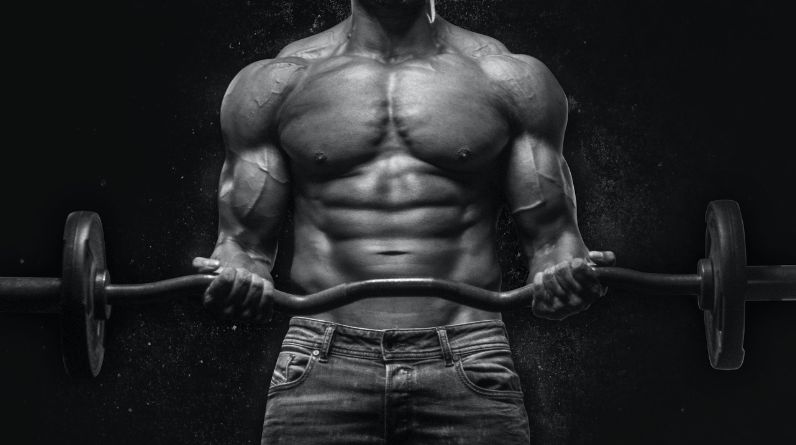
Unleash Your Inner Hercules by Unlocking the Power of Creatine
You have the weight rack. You’ve put on your game face. And you’ve got your heavy metal anthem playlist ready to go. But one item is missing in your quest to become the next Hercules of the gym: creatine. “Creatine?” I know what you’re thinking. That sounds like a scene from a science fiction film.” But believe me, it’s as real as the benefits you’re after.
So, let’s go on a voyage to uncover the mysteries of this miracle supplement, delving deep into what creatine is, how it works, and why it’s a must-have in your armory if you’re serious about sculpting your body into a muscular masterpiece.
Creatine: The Not-So-Secret Weapon of Bodybuilders
Creatine, the well-known secret weapon of bodybuilders and athletes. It’s not some unique potion concocted in mad scientists’ lairs. It is, in reality, a naturally occurring substance composed of amino acids that can be found in trace amounts in some foods and generated by your own body. It’s your body’s way of supporting your ambition to become the next Arnold Schwarzenegger.
Creatine Alchemy: From Powder to Power
“How does this stuff actually work?” you may be wondering. Consider creatine to be the alchemical gold of the fitness world. It is a fine, white powder that, when taken, undergoes a metamorphosis within your body. Creatine phosphate is formed when it mixes with a phosphate molecule and is stored in your muscles.
The ATP Mysteries: Your Body’s Energy Currency
Wait a minute, phosphate molecules and energy transformations? What’s the deal with that? This is when things become interesting. Adenosine triphosphate, or ATP, is your body’s principal energy currency. When you need to undertake a burst of high-intensity exercise, such as lifting heavy weights or sprinting, your muscles consume ATP for energy.
Your muscles, on the other hand, cannot store vast amounts of ATP. This is where creatine comes into play. To rebuild ATP quickly, creatine phosphate gives its phosphate molecule to ADP (adenosine diphosphate). This means you have more energy for Herculean attempts and can power through your workouts with greater intensity and strength.
Benefits Galore: Why Bodybuilders Love Creatine
So, what’s the big deal about? Why do sportsmen and bodybuilders swear by creatine?
1. Amplified Strength and Power
If you’ve ever experienced a training plateau, you know how irritating it can be. Creatine could be the key to breaking over that barrier. It increases the ability of your muscle cells to create energy, increasing your strength and power and helping you to lift heavier and push harder throughout your workouts.
2. Amazing Muscle Gains
Every bodybuilder’s dream is to gain lean muscular mass. Creatine promotes muscular growth by raising the water content of muscle cells and enhancing protein synthesis. More water and protein equals more muscle gains.
3. Increased Physical Endurance
Have you ever had the feeling that you could go the extra mile if only your body would cooperate? Creatine could be the solution. It helps to postpone muscular exhaustion by giving a rapid source of energy to your cells. This means you can lengthen your exercises, do more reps, and improve your overall exercise performance.
4. Faster Recovery
When you’re a bodybuilder, sore muscles are unavoidable. Creatine, on the other hand, helps your muscles recover faster. This means you’ll have less rest between strenuous sessions, allowing you to stick to a consistent training plan.
5. Enhanced Brain Function
“Wait, what does the brain have to do with bodybuilding?” you may be thinking. Actually, quite a bit. Creatine is not only a muscular supplement; it is also a cognitive supplement. It promotes brain health and cognitive function, allowing you to remain intellectually alert and concentrated throughout your workout.
The Creatine Fountain: Food Sources
You may be thinking, “Can’t I just get creatine from my diet?” You can, but there is a catch. While animal-based foods like beef, pork, and fish contain trace amounts of creatine, you’d have to consume a lot of them to achieve the creatine levels needed to noticeably improve your athletic performance. A pound of raw beef, for example, has only about 1 gram of creatine.
As a result, most sportsmen and bodybuilders use creatine supplements for practical objectives. These supplements are more convenient and cost-effective, and they ensure you obtain the right dosage to support your fitness goals.
Creatine Types and Forms: Breaking the Code
Let’s get down to business. When it comes to creatine pills, there is no such thing as a one-size-fits-all approach. There are various types and shapes, each with its own set of advantages. Here’s how it works:
1. Creatine Monohydrate
The Original Gangster (OG) of creatine pills. Creatine monohydrate has been around the longest and has received the most attention. It is both cost-efficient and effective. It is frequently found as a white, odorless powder that can be blended with water or other liquids. It’s a favorite among bodybuilders due to its consistent results.
2. Creatine Hydrochloride (HCL)
Creatine HCL may be a better option for those who experience stomach discomfort when taking creatine monohydrate. It’s more water-soluble and, in theory, takes fewer doses to provide the same impact.
3. Creatine Ethyl Ester
Creatine ethyl ester is intended to improve absorption. It is said to have higher bioavailability than creatine monohydrate, however scientific data is lacking. Some bodybuilders swear by it, while others cling to tried-and-true methods.
4. Creatine Nitrate
Creatine nitrate mixes creatine with nitrates, which may promote vasodilation and blood flow. This could lead to stronger muscular pumps during workouts. If you like that pumped-up feeling, this is an excellent option.
5. Buffered Creatine
Buffered creatine attempts to limit creatine conversion to creatinine, a waste product that does not help to muscle building. It’s intended to be more pH-stable, which could increase its effectiveness, although further research is needed.
6. Micronized Creatine
This is essentially creatine monohydrate broken down into tiny particles. It’s frequently marketed as being easier to mix with beverages, although its effectiveness is on par with normal creatine monohydrate.
Which shape to choose is often a matter of personal preference and how your body reacts to each type. Some bodybuilders may prefer one form over another, so it’s worth testing to determine what works best for you.
Conclusion
Creatine emerges as the not-so-secret weapon in the world of bodybuilding, where every ounce of performance gain counts. It is not a mystical potion, but rather a scientifically-backed substance that has repeatedly demonstrated its ability to improve strength, power, and muscular increases.
So, if you’re ready to channel your inner Hercules, creatine could be the trigger you’re looking for. It’s a flexible supplement that you may safely integrate into your regimen to give you an extra edge in your never-ending quest for muscle-bound greatness. Remember that, while creatine is an effective ally, it is not a quick fix. Workouts, food, and determination are still the most important factors in achieving your bodybuilding goals. Creatine, in all its powdered splendor, is merely a sidekick that assists you on your journey.
Now, darling bodybuilder, go forth and let creatine be your not-so-secret superpower. Conquer the weights, sculpt your body, and earn Hercules’ approval. Your path to muscle-bound glory awaits you.
Frequently Asked Questions
1. Is it safe to take creatine for bodybuilding?
Creatine is largely regarded as one of the safest and most thoroughly researched bodybuilding supplements. It has been thoroughly researched and is supported by several sports and health organizations. Creatine is regarded safe for the vast majority of people when used in accordance with prescribed standards, which typically include a loading phase followed by a maintenance dose. While some people may have minor adverse effects such as stomach discomfort or diarrhea, these are uncommon, emphasizing the supplement’s safety. Creatine, like any other substance, must be used cautiously.
2. Do I need to load creatine?
While adding creatine is an option, it is not required. Loading is taking a greater dose at first to quickly saturate muscle creatine levels, followed by a maintenance dose. Many people, however, choose to skip loading and start with the maintenance dose right away, which is usually 3-5 grams per day. This method takes a little longer to get maximum muscle creatine levels, but it is just as effective in the long run. Whether or not you load is a question of personal preference.
3. What dosage of creatine should I take?
The typical starting dose for creatine is 3-5 grams per day. This is the maintenance dose, ensuring that increased muscle creatine levels are maintained. While some people take higher quantities, there is frequently no additional benefit because muscles can only retain so much creatine. The key is daily consistency, whether you start with a loading phase or with the maintenance dose right away. Starting with 3-5 grams per day is a good place to start, with room for adjustment based on individual reaction.
4. When should I take creatine?
Although the precise timing of creatine use is not crucial, many people prefer to consume it post-workout, usually alongside a carbohydrate source to improve absorption. Muscles are more sensitive to nutrition after a workout because of increased blood flow and insulin sensitivity. Carbohydrates, particularly those with a high glycemic index, might increase insulin levels and hence facilitate creatine uptake. Taking creatine at other times of the day, however, is equally effective. Consistency in daily consumption is more important than precise timing.
5. Is it OK to combine creatine with protein shakes?
Creatine is easily coupled with protein shakes. This is especially helpful for people who are used to drinking protein drinks after working out. Creatine in the recommended amount of 3-5 grams per day combines well with most protein shake flavors without drastically altering taste. This mixture works well as a post-workout recovery drink, replenishing protein and creatine levels and stimulating muscle healing and growth.
6. Will creatine cause me to gain water weight?
When you first start taking creatine, you may see a transient increase in water weight. This impact is due to creatine’s ability to attract extra water into muscle cells, hence improving hydration. This water retention is typically temporary and restricted to muscle tissue, resulting in a modest rise in body weight, which is commonly interpreted favourably as a sign of successful intramuscular hydration. Proper hydration is critical for overall water balance.
7. Is it safe to consume creatine on a long-term basis?
Creatine is deemed safe for long-term use, and many bodybuilders and sportsmen utilize it without incident. Extensive studies and several endorsements from sports and health groups back up the long-term safety of the product. Following established rules, including cycle phases, can help to enhance safety even further. However, there is no strong evidence that long-term creatine supplementation is dangerous when used carefully.
8. Do I need to take a creatine break?
Cycling off creatine is not required, although it is a personal preference. Some people choose to cycle creatine, which involves periods of use followed by brief intervals, in order to assess their body’s response when they resume supplementing. These cycles can last anywhere from a few weeks and several months. Cycling is not required, and many people consume creatine on a daily basis without incident.
9. Can women use creatine for bodybuilding?
Creatine is not gender-specific and can benefit both men and women who are pursuing bodybuilding ambitions. Its advantages, including as increased muscle strength and performance, are not gender specific. Creatine can be safely and efficiently used into the bodybuilding practices of women.
10. Are there any side effects of creatine?
Creatine is typically safe when used as intended and rarely produces negative effects. The majority of people have no adverse responses. Nonetheless, a tiny percentage of people may experience minor side effects such as stomach discomfort or diarrhea. Adequate hydration is essential when using creatine to avoid these potential side effects. Overall, when used carefully, creatine is associated with little side effects.






